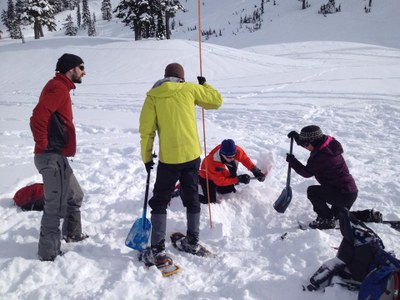
Clinic
AIARE Avalanche Rescue (1-Day Clinic) - Baker Lodge
- Sun, Jan 19, 2020
- Seattle Avalanche Safety Committee
- Avalanche Safety
- Adults
- For Beginners (Getting Started Series)
- $130.00 $175.00
- 3 (26 capacity)
- FULL (12 capacity)
- Cancellation & Refund Policy
Meet at 8AM in the parking lot of the Baker Lodge
COURSE DESCRIPTION
This is an AIARE certified Avalanche Rescue class consisting of 8 hours on snow at the Mount Baker Ski Area. With a 3-1 student to instructor ratio, we will review all aspects of companion rescue, from beacon basics up to advanced multiple burial techniques and evacuation of injured patients. People who have not taken an AIARE 1 will learn how to efficiently perform companion rescues, while experienced backcountry users will improve in efficiency and speed.
The only way to become competent at avalanche rescue is to practice it every year. Being a good backcountry partner means having the right gear and being practiced enough to use it efficiently.
SCHEDULE
- Avalanche Rescue class: 8:00am - 4:00pm
- Location: Mount Baker Ski Area
WHAT IS COVERED
Each participant will have the opportunity to receive professional, one-on-one coaching and feedback on their rescue skills. The day will begin by reviewing beacon and avalanche equipment basics. Students will be broken into groups based on prior knowledge to ensure appropriate pacing of instruction. Students will have a chance to complete numerous, realistic timed scenarios from basic single, shallow burials to complex multiple burial scenarios. Advanced multiple burial search techniques such as the three circle method and flagging will be taught, in addition to basic patient evacuation skills using tarps or improvised litters.
STUDENT LEARNING OUTCOMES
At the end of the Avalanche Rescue class students should be able to:
- Know what to do if they or a member of their party is caught in an avalanche
- Know how to use gear necessary for avalanche rescue, including advanced features (such as flagging)
- Competently conduct a single or multiple burial companion rescue alone or as a member of a larger group
- Set up a realistic scenario in order to practice an avalanche rescue response
- Improve response companion rescue skills and times
- Develop a plan for continued practice
- Understand the challenges of evacuating an injured patient
DOES THIS CLASS TEACH ME ALL I NEED TO KNOW?
This class ONLY focuses on companion rescue, and not on the other essential elements of avalanche education such as planning, using avalanche forecasts, identifying avalanche terrain, making observations, making appropriate terrain choices, etc. If you have not taken an AIARE 1 class recently, we STRONGLY recommend taking either an Avalanche Awareness Class or an AIARE 1 class before going into avalanche terrain.
CANCELLATION AND ATTENDANCE POLICY
During the open registration period, students can cancel their registration and receive a refund of their course fee minus a $50 cancellation fee. After registration closes, students will receive no refunds for cancellations. Attendance is required at all classes and no make-up classes are provided.
WHO IS AIARE AND WHERE DOES THIS COURSE FIT IN THEIR PROGRESSION?
AIARE is an organization that sets standards and best practices for avalanche education and rescue. For the majority of users, this course is intended to provide routine practice, but for those wanting to continue on with their avalanche education, this course is required in order to take an AIARE 2 or Pro 1 course.
Badges
participants will earn:
Baker Lodge
-
Green Trails Mt Shuksan No. 14
Green Trails Mount Baker Wilderness Climbing No. 13SX
Trails Illustrated North Cascades National Park - See full route/place details.
Required Equipment
- Either backcountry skis / splitboard with skins, or snowshoes.
- A metal shovel designed for avalanche rescue (no plastic shovels)
- A full length avalanche probe (Minimum length of 240cm / Recommended length of 280cm)
- An avalanche beacon (a 3 antenna beacon is required)
- Clothes suitable both for standing around and getting exercise outdoors all day in possibly cold, windy, snowy or even rainy conditions.

 Avalanche Rescue Course
Avalanche Rescue Course